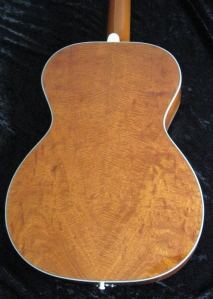Final Assembly
The guitar is now polished to a high gloss are ready to have the hardware installed.
Before installing the tuning machines I need to remove the oversprayed lacquer from the holes that were drilled into the peghead or the machines will not turn smoothly. This is accomplished with a rattail file and must be done very carefully to avoid chipping the lacquer in the string slots.
Next, I clean up the fretboard, particularly the ends of the frets where some lacquer invariably seeps under the tape that was used to mask the board during spraying.
As with most of my guitars, the nut for this one will be made of bone. The nut is the piece next to the peghead that holds the strings in proper alignment. Bone is a very commonly used material because it lasts a long time, is dense enough that slots can be filed into it for each string, and has what are generally considered to be good acoustic properties for a guitar. I purchase nut “blanks” that are roughly cut to 1/4″ X 3/8″ X 2 1/2″ dimensions. Here is a picture of the nut blank
I use a belt sander to work the nut blank down to almost the final dimensions I need. This is a tricky process, mainly because if I let my concentration lapse I will quickly grind off a couple fingernails and even some skin on my thumb or fingers. This method is the most efficient way I have found to perform this job, so I think that the risk to my nails and skin is justified. I have done it enough times now that I often walk away with my nails intact.
The final dimensioning of the nut is done with hand sanding. I start with 100 grit paper and eventually work my way up to 320 or 400 grit to give the nut a nice finished shine. Here is the nut sitting in its slot at the end of the fretboard.
In the above picture, a pencil line is visible. This line reflects the arc of the fretboard and it tells me how deep to cut the slots in the nut for the strings. I use a number of different width files to cut the string slots after their exact location is carefully marked on the top surface of the nut. I don’t make a lot of 12 string guitars and when I got to this stage on this instrument, I was reminded of how much more difficult it is to make the nut on this sort of guitar. Not only do the slots have to be spaced at just the right intervals in order for the string positions to feel right to the player, but the slots also have to place the strings at exactly the same height off the first fret (approximately 0.010″) so all of the strings press down evenly. It took a couple nut blanks and several hours for me to get a nut I was satisfied with on this guitar.
After making the nut, I glue the bridge onto the soundboard. The bridges on the original Stella guitars were not glued on because the tension of the strings from the tailpiece was enough to hold the bridge in place, as on an archtop guitar, but many were later glued to the top and my customer thought that would be a good idea so he wouldn’t have to worry about the bridge getting displaced. Here is a photo of the bridge position being masked off and the lacquer being scraped away to expose bare wood.
After all of the lacquer is scraped away, the bridge is glued to the top. It is held in place with a clamp and fixture.
After about 24 hours, the clamp is removed and I will make a bone saddle in much the same way I made the nut. The saddles on most guitars do not have any slots in them, the strings rest on the top and are held in place by the amount of tension they develop when tuned to pitch. However, on this guitar there is a very shallow angle between the tailpiece and the bridge saddle, so I did have to make a very small notch in the saddle to hold each string in position.
The last steps are installing the metal tailpiece and the strings. After the strings are installed and the guitar sits for a day or so under the full tension of the 12 strings, I make any necessary adjustments to the truss rod in the neck and to the string height, at either the nut or the saddle. Finally, the guitar is finished!!!
Thank you for reading this. Please let me know if it was worthwhile.











